

Gyere el Talk Fusion webkonferencia előadásunkra! Nem kell mennem sehova? Nem termék eladás? Azonnal pénzt keresek? Talk Fusion. Company: Utilities battery video. Energy storage. The Llyn Stwlan dam of the FfestiniogPumped Storage Scheme in Wales.

The lower power station has four water turbines which can generate a total of 360 MW of electricity for several hours, an example of artificial energy storage and conversion. History[edit] Energy storage as a natural process is as old as the universe itself - the energy present at the initial formation of the universe has been stored in stars such as the Sun, and is now being used by humans directly (e.g. through solar heating), or indirectly (e.g. by growing crops or conversion into electricity in solar cells).
As a purposeful activity, energy storage has existed since pre-history, though it was often not explicitly recognized as such. Electricity Storage. The Need for Electricity Storage Storage on the electric grid is the only environmentally friendly way to reliably add large amounts of intermittent renewable generation, such as wind and solar.
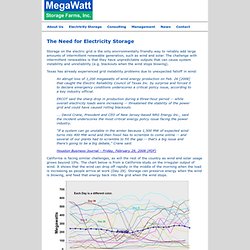
The challenge with intermittent renewables is that they have unpredictable outputs that can cause system instability and unreliability (e.g. blackouts when the wind stops blowing). Texas has already experienced grid instability problems due to unexpected falloff in wind: An abrupt loss of 1,200 megawatts of wind energy production on Feb. 26 [2008] that caught the Electric Reliability Council of Texas Inc. by surprise and forced it to declare emergency conditions underscores a critical policy issue, according to a key industry official.
Companies & associations. Government sources. The Challenge for Green Energy: How to Store Excess Electricity. 13 Jul 2009: Report by jon r. luoma “Why are we ignoring things we know?
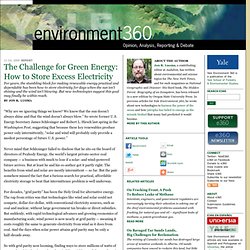
We know that the sun doesn’t always shine and that the wind doesn’t always blow.” So wrote former U.S. Energy Secretary James Schlesinger and Robert L. The Convoluted Economics of Storing Energy. Energy Storage for Solar Power. BrightSource Energy has become the latest solar thermal power company to develop a system for generating power when the sun isn’t shining.

The company says the technology can lower the cost of solar power and make it more reliable, helping it compete with conventional sources of electricity. The company, based in Oakland, California, is building one of the world’s largest solar thermal power plants. The 392-megawatt solar plant in Ivanpah, California, however, will not include the storage technology. Instead, BrightSource is working with utilities to determine which future projects could best benefit from storage.
The limits of energy storage technology. Editor’s note: The following column was co-authored by Alex Johnson, a post-doctoral fellow at Harvard University.
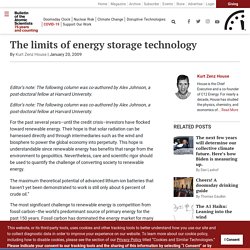
Thermal Energy Storage Myths. FAQ: Energy Storage for the Smart Grid. New Battery Could Be Just What the Grid Ordered. Utilities need cheap, long-lasting ways to store the excess energy produced by power plants, especially as intermittent power from solar and wind farms is added to the mix.
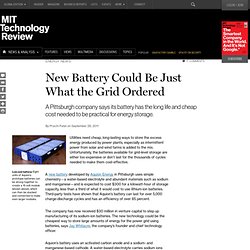
Unfortunately, the batteries available for grid-level storage are either too expensive or don’t last for the thousands of cycles needed to make them cost-effective. A new battery developed by Aquion Energy in Pittsburgh uses simple chemistry—a water-based electrolyte and abundant materials such as sodium and manganese—and is expected to cost $300 for a kilowatt-hour of storage capacity, less than a third of what it would cost to use lithium-ion batteries. Third-party tests have shown that Aquion’s battery can last for over 5,000 charge-discharge cycles and has an efficiency of over 85 percent.
The company has now received $30 million in venture capital to step up manufacturing of its sodium-ion batteries. Aquion’s battery uses an activated carbon anode and a sodium- and manganese-based cathode. A Simple Way to Boost Battery Storage. Lithium-ion battery electrodes bound together by a new highly conductive material have a much greater storage capacity—a development that could eventually increase the range of electric cars and the life of smart-phone batteries without increasing their cost.

Unlike many high-capacity electrodes developed over the last few years, these can be made using the equipment already found in today’s battery factories. The key is a stretchy, highly conductive polymer binder that can be used to hold together silicon, tin, and other materials that can store a lot of energy but that are ordinarily unstable. Batteries with 10x more capacity and 10x faster charge. Clusters of silicon (green) between graphene sheets allow for more lithium atoms (blue) in electrodes for increased charging capacity and nanoholes speed up ion flow for faster charging speed (credit: Northwestern University) Northwestern University engineers have created an electrode for lithium-ion batteries — rechargeable batteries such as those found in cellphones and iPods — that allows them to hold a charge up to 10 times greater and charge 10 times faster than current batteries; they could also pave the way for more efficient, smaller batteries for electric cars.

The technology could be seen in the marketplace in the next three to five years, the researchers said. “We have found a way to extend a new lithium-ion battery’s charge life by 10 times,” said Harold H. Kung, professor of chemical and biological engineering. A New, Fast-Charge Battery Could Jumpstart the Electric Vehicle Market. InShare2 This entry is the latest in a Worldwatch blog series on innovations in the climate and energy world.
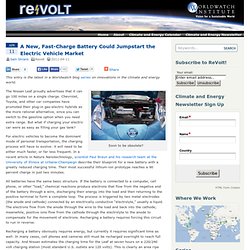
Soon to be obsolete? The Nissan Leaf proudly advertises that it can go 100 miles on a single charge. Chevrolet, Toyota, and other car companies have promoted their plug-in gas-electric hybrids as the more rational alternative, since you can switch to the gasoline option when you need extra range. But what if charging your electric car were as easy as filling your gas tank? For electric vehicles to become the dominant mode of personal transportation, the charging process will have to evolve: it will need to be either much faster, or far less frequent.
Future energy sources and energy storage. Market analysis. Energy Storage Device Market to Hit $12 Billion By Decades End. A soon-to-be-released marketing report from Business Communications Co.

(BCC) of Norwalk, Conn., predicts that the total global market for capacitors, flywheels and superconducting magnetic energy storage (SMES) systems will rise at an average annual growth rate (AAGR) of 5.9%, from $9.2 billion in 2005 to $12.2 billion in 2010. The report, titled “RE-145 Global Markets for Capacitors, Flywheels and SMES Systems: Emerging and Mature Technologies,” examines a variety of device types within these broad technology categories, projects their market growth over the next five years and discusses the factors affecting their growth. According to BCC, the market for emerging energy storage systems is segmented among a number of devices that are discussed in the new report.
These devices include capacitors, batteries, fuel cells, flywheel energy storage (FES) systems, SMES systems and compressed air energy storage (CAES) systems. Emerging capacitor technologies include several capacitor types. Greentech Media: Grid Energy Storage: Big Market, Tough to Tackl. Grid-scale energy storage – it's a tricky market to tackle, but one that offers billions of dollars to those that can get it right. Greentech Media: A123 Batteries to Help Stabilize Electric Grid. Unnamed electric utilities have signed on to use A123Systems’ lithium-ion batteries to help stabilize the grid, CNET reported this week. Ric Fulop, vice president for business development at A123Systems, said the company has been working with General Electric to develop batteries to help squeeze more power into the grid, when needed, so that the power supply matches the demand, according to the CNET story.
GE, which led a $40 million round of funding for A123 in February, already supplies products such as software to utilities. The idea of using batteries for the electric grid has long been a Holy Grail in the industry, but the cost and size of the batteries – including all the maintenance and replacement every few years – have been major impediments. Battery companies have been making some strides, however. A123’s projects are focused on shorter-term stabilization. It’s an alluring market, as power fluctuations and outages are costly. Watertown, Mass.